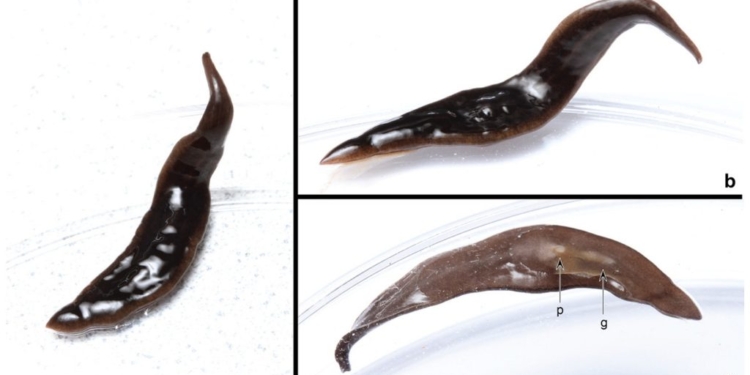New Predatory Flatworm Invades Southern U.S.
Gizmodo ^ | September 25, 2024 | Ed Cara
Posted on 09/25/2024 8:56:27 PM PDT by Red Badger

A living Amaga Pseudobama specimen in a petri dish, observed from three different views. © Justine, et al/PeerJ
Scientists have discovered a never-before-seen invasive species of land flatworm living in North Carolina, Florida, and possibly other parts of the U.S.
The United States appears to be playing host to a novel wormy invader. In a new study this week, scientists report on the discovery of a never-before-seen species of flatworm living in North Carolina, Georgia, Florida, and possibly other parts of the U.S. The predatory worm likely originated from South America and closely resembles other invasive species, which will hamper efforts to track its presence in the U.S., the researchers say.
The new worm—named Amaga pseudobama—is a type of terrestrial, or land, flatworm. These worms tend to natively live in tropical environments closer to the equator, making the discovery of this species in the U.S. both interesting and potentially concerning. Non-native, or invasive, species can often throw off the balance of an ecosystem by outcompeting native animals in the same niche or by consuming precious resources. At this point, though, much about the newly discovered worms remains unknown.
“It has not been observed in the wild or native habitats, so we don’t know much about how it interacts with its environment. We can infer from what we know about related species, but we don’t know precisely what it preys on, how quickly it reproduces, and so on,” said Matt Bertone, a researcher from North Carolina State University, in a statement from the university.
Researchers from France, Australia, Poland, and the U.S. all played a part in unraveling the identity of the mystery worm. In 2020, Bertone was sent samples from a commercial plant nursery that had found specimens of the worm in some of their flowerpots. Based on photographs, the flatworm experts that Bertone consulted initially identified the worm as Obama nungara, a species of land flatworm from South America that has begun to widely invade parts of Europe in recent years (“Obama” is a reference to the worms’ body shape in the Brazilian language Tupi, not to any former world leaders).
But when Bertone’s colleagues in France and Australia got to physically examine the specimens, they realized this initial guess wasn’t right. After extensively analyzing its morphological features and its genetics, the team eventually determined that the worm was actually a previously unknown member of the genus Amaga. Given the superficial similarity to O. nungara, though, the researchers did choose to allude to it in the naming of their new discovery. The team’s findings were published in a paper Tuesday in the journal PeerJ, with the catchy title: “A new species of alien land flatworm in the Southern United States.“
While some flatworms are parasites, land flatworms such as O. nungara and A. pseudobama are predatory, typically hunting after various creepy crawlies, such as earthworms, snails, and other invertebrates. These worms tend to live in tropical areas, and as best as the researchers can tell, A. pseudobama probably originates from somewhere in South America. Since its arrival to the U.S., the worm has likely spread further than we currently know.
Bertone received specimens from elsewhere in North Carolina, hundreds of miles away from the first location, while some of the worms were found on plants that initially came from Georgia. Additionally, the researchers found specimens of A. pseudobama collected in Florida that date back to 2015, suggesting that the worm has been stateside for at least a decade. It may also possibly live in other areas of the Southern U.S., including Texas and California, based on photographic reports of similar-looking flatworms uploaded to the website Naturalist that the researchers found.
Studying the impact of A. pseudobama on its new home is important, though its close resemblance to O. nungara and other land flatworms will make that harder. The scientists hope that their research provides a good start to that work.
“Finding a new flatworm species is not necessarily a surprise – these animals are so little studied that there are likely many species awaiting discovery,” Bertone said. “However, the fact that we know so little about them is one reason they are worth paying attention to. Do they pose a risk to native worms and, by extension, native ecosystems? We have to study these species to find out. And the first step in that process is clearly identifying a species and naming it.”
TOPICS: Agriculture; Gardening; Health/Medicine; Pets/Animals
KEYWORDS:

Click here: to donate by Credit Card
Or here: to donate by PayPal
Or by mail to: Free Republic, LLC - PO Box 9771 - Fresno, CA 93794
Thank you very much and God bless you.
OBAMA WORM!.....................
1 posted on 09/25/2024 8:56:27 PM PDT by Red Badger
Disclaimer: Opinions posted on Free Republic are those of the individual posters and do not necessarily represent the opinion of Free Republic or its management. All materials posted herein are protected by copyright law and the exemption for fair use of copyrighted works.
FreeRepublic.com is powered by software copyright 2000-2008 John Robinson

 By Free Republic | Created at 2024-09-26 03:57:59 | Updated at 2024-10-01 04:11:59
5 days ago
By Free Republic | Created at 2024-09-26 03:57:59 | Updated at 2024-10-01 04:11:59
5 days ago


